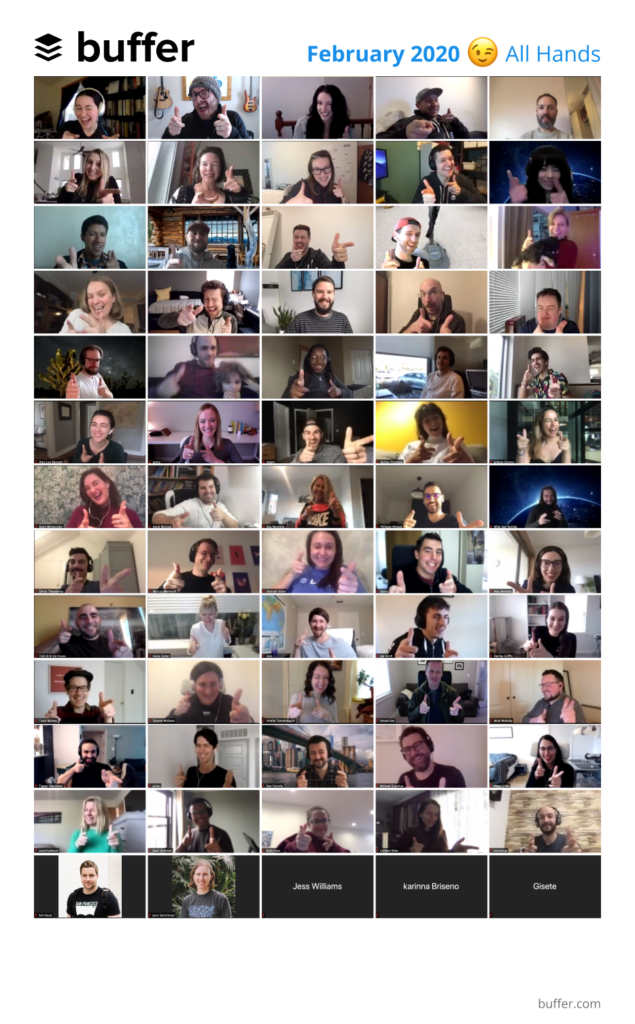Prefer to listen? Here’s the audio version of this post!
All Hands, town hall, tea time — there are many names for the meeting where everyone comes together for company updates and announcements.
For us, All Hands is not only an exciting time to see everyone’s smiling faces at once but also a big part of our value to default to transparency. Buffer’s All Hands meetings are a great place to openly communicate with the whole company at once.
As a fully-remote company operating in multiple time zones, our All Hands might look a bit different than traditional, office-based meetings. While it’s tricky to get everyone online at once, we work hard to make the gatherings informative, fun, and uniquely tailored to our remote culture
We’re excited to share our current process for running our All Hands meetings with you, so let’s dive in!
How A Remote All Hands Operates Differently
Being an entirely remote team means our All Hands are a little different than an office-based meeting.
First off, we gather in a virtual place instead of a physical one, using a tool called Zoom that lets every team member join in via video. It’s always neat to see people’s faces (and not just their profile pictures), plus Buffer babies, puppies, and other pets and family members often make it onto the screen as well.
Being spread across the world is awesome for many things, but timing wise, it’s tough for gathering people in one All Hands. We schedule the events well in advance using Google Calendar invitations, and we try to position the call so that as many people as possible can make it to the live event, which means prioritizing a time that works for both the U.S. and Europe. That does mean that it can be tough for teammates in Australia and Asia to join in, and we definitely don’t expect folks to wake up in the middle of the night to attend.
We always record every All Hands so that whether someone is sleeping, off on family leave or vacation, or just can’t make it for some reason, anyone can catch up on what was shared. We’ve also experimented with “viewing parties” for Australia and Asia to make the experience a bit more special!

Exactly How We Structure All Hands at Buffer
Welcome and Agenda
On the day of an All Hands, we share the Zoom link in Slack five minutes or so before the event so everyone can start jumping in. It usually takes a few minutes for everyone to jump on the call.
We recently started a fun new tradition during the gathering of everyone on the call — letting teammates serve as DJ or live musician! We’ve got a collaborative Spotify playlist we can pull from, and we’ve also got plenty of musically minded and talented teammates. During our last All Hands, one of our teammates played some soothing acoustic guitar as people were joining!
Once we’ve assembled, we hit record and usually our Director of People, Courtney, will start things off by saying hello and letting everyone know the agenda for the All Hands. Often, we’ll also share a link to a Paper doc for folks to ask questions or share thoughts throughout the meeting. Zoom also has a chat feature, so by this time, the chat room has lit up with folks saying hi and checking in.
Celebrations
We love celebrating each other. While we do a lot of it in Slack and Threads, it’s also fun to get a chance to applaud via video chat, so celebrations are the first thing we do in every All Hands. We encourage teammates to un-mute their mics so we can all hear each other celebrating and clapping during this portion. This makes a big difference for us!
Here are a few things we celebrate:
- Buffer-wide news, like receiving awards and reaching company or financial milestones
- Bufferversaries and new teammates (Bufferversary = anniversary of when someone started at Buffer)
- Promotions and role changes
- Teammate life events — we bring our whole selves to work, which means we celebrate lots of things beyond work! When Bufferoos do things like win a competition, move to a new city or home, run a marathon, grow their family, put on an event, or experience any other exciting life events, we want to cheer them on.
- Shout outs and gratitude — teammates often recognize each other for doing great work. We try to facilitate this with a lightweight form teammates can fill out ahead of time, as well as a gratitude Slack channel.
Update from Joel
At this point in All Hands, our CEO Joel will jump in with an update from his perspective on how things are doing overall at Buffer. He’ll usually share more about our company goals, vision, and milestones.
Physical Activity Break
Our All Hands usually last about an hour (sometimes a bit longer). That’s a long time to watch a screen, so we’ve recently incorporated a physical activity component about midway through. At one All Ahnds, we had a yogi teammate lead some desk stretches! It was lots of fun, although teammates working from coffee shops might have gotten a few confused looks.
Area Updates
After Joel speaks, representatives from each team give an update on their area. It’s a great way to get a quick read on what’s going on in Engineering, Advocacy, Marketing, Product, and People. This is an opportunity to hear from teams that teammates may not frequently interact with and hear what they’ve been up to.
Group Photo
It wouldn’t be a team gathering if we didn’t take a photo! We usually make fun emoji signs or bring an object or animal with us into the photo.

There are a few other things that happen during All Hands that are pretty unique to a remote All Hands, though they aren’t exactly part of the schedule.
For one thing, we use the chat feature in Zoom a lot. Since we wouldn’t be able to shout out our reactions without talking over the person presenting, we use the chat feature to ask questions, share comments, gratitude, and celebrations during updates. It can be really validating to share an update, and then see a stream of emoji-filled celebrations come through in the chat!
There are also quite a few screenshots taken. Since babies, pets, and partners often make appearances during All Hands, we tend to take screenshots and share them in Slack to identify these fun moments (as with a team of 70+, it’s difficult to see all the moments in Zoom on one screen!) and talk about how happy we are to be seeing each other. It’s often a game to figure out which Bufferoos happen to be together in person that day, based on backgrounds.
How Often We Have All Hands
Since it’s a challenge of its own to get the whole Buffer team on one call, and some people might stay up past their usual work/sleep schedule, we hold All Hands meetings every other month.
The signals we’ve been getting from the team tell us they’d like to get together more often, so we’re also doing Town Halls where our CEO Joel specifically sets aside time to answer any questions that come up.
There are many opinions about the best cadence of All Hands meetings. At Zappos, they shut down their entire office once a year for employees to meet off-site for their All Hands. On the other end of the spectrum, both Google and Facebook have weekly All Hands and Q&A sessions with their teams.
Over to You
The All Hands experience is different at every company, and that’s something to celebrate! For example at Zappos, “employees…who are passionate about singing and dancing regularly have opportunities to perform during All Hands.” We love the idea of embracing what our teammates are excited about, and we’re always looking for ways to make ours unique, personal and fun.
What is your All Hands like? We’d love to know in the comments!
Try Buffer for free
190,000+ creators, small businesses, and marketers use Buffer to grow their audiences every month.




